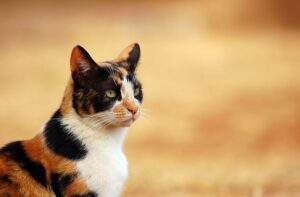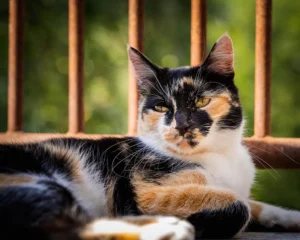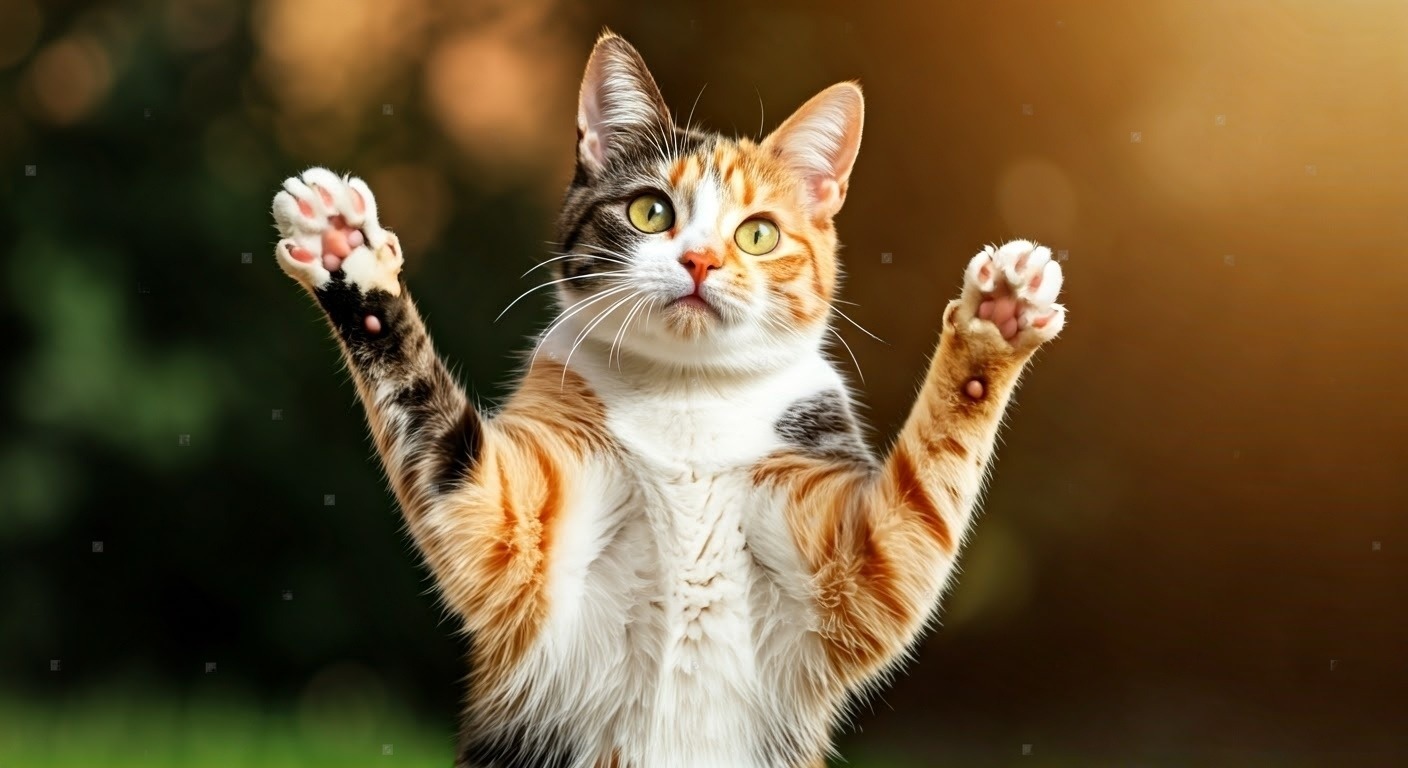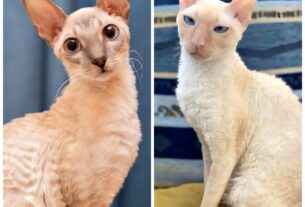Table of Contents
ToggleIntroduction of Calicos
Hey cat lovers! If you have ever been captivated by the beautiful coat colors of a cat, then there’s a good chance you’ve met an amazing calico cat. These fabulous cats cannot be classified as a separate breed, but they belong to the family of domestic cats. Their unique tri-color coats (a mix of white, orange, and black) set them apart. Additionally, the tri-color calico pattern can be combined with tabby patterning, called a tortoiseshell tabby with white. Most calico cats are female, and male calicos are rare due to their genetics. From their unique coloration to genetics, from care to the amazing history of calico cats, we will discuss everything about this fascinating group. So let’s begin!
Calico Cats’ Color Patterns
As calicos are not a specific breed, they can be recognized by their stunning color patterns. These colored patches can include white, black, and orange. Other color combinations like cream, reddish-brown, and gray-blue are also present in calico cats. Many people confuse calico cats with tortoiseshells. The main difference is that torties have a blend of black and red coats, while calicos have a white-based mixed coat with patches of vibrant orange color. Some types of calicos have softer coats of colors, like blue and cream, known as “diluted calicos.”
Many famous cat breeds like Maine Coon, American Shorthair, British Shorthair Blue, Japanese Bobtail, and Persian can show the calico color pattern. Their attractive color pattern makes calico cats a favorite among feline lovers.
Physical Appearance of Calico Cats
Calico cats are famous for their gorgeous tri-color coats, which include white, black, and orange. The white color can cover anywhere from 25% to 75% of the coat, along with black and orange. The legs, abdomen, breast, and feet of a calico are usually covered with white fur.
Eye color: Their eye color can vary, just like their coat. Calicos’ eye color might be blue, green, copper, or even “odd-eyed.”
Height and weight: Calico cats have an average height of approximately 18 inches, and their weight can be up to 12 pounds.
How Does the Genetics of Calico Cats Work?
Role of X Chromosomes in Calico Coloration
The interesting patches of black, orange, and white colors on the fur of a calico cat are directly impacted by their X chromosomes. Female cats have two X chromosomes (XX), and male cats have one X and one Y (XY) chromosome. The fur color gene is present on the X chromosome, and it has two different alleles: one allele for orange color and one for black color. Why calico cats have such unique coloration is due to the interaction of these alleles on the X chromosome .
.
In females, one X chromosome from the mother and one from the father provides an allele, which may be black or orange. A process named lyonization happens during embryonic development, in which one of the X chromosomes is randomly deactivated. If the black allele is deactivated, the fur will be orange, and if the orange allele is deactivated, the fur will be black.
On the other hand, male cats do not show multi-color patterns because they have only one X chromosome. However, in rare cases, some male calicos can show multiple colors on their fur because of a genetic condition called Klinefelter syndrome (XXY). In this condition, male cats have an extra X chromosome.
Why Male Calico Cats Are Extremely Rare?
Male calico cats are extremely rare because of their unique genetic composition. Calico coloration occurs due to the X chromosome, which carries the gene for both orange and black fur color. Females have two X chromosomes, which is why they can show both colors. However, males have only one X and one Y chromosome (XY), which is why they can display only one color—black or orange.
Male calico cats are an uncommon and unique discovery for cat lovers, as their estimated occurrence is less than 1 in 3,000 cats.
Essential Care Tips for Calico Cats
Feeding and Nutrition for Calico Cats
When it comes to providing the best nutrition for calico cats, a protein-rich diet is a key factor for their overall well-being. Calico cats enjoy foods similar to other cats, which may include dry kibble, wet food, or canned meals. It is important that 90% of their diet is made up of high-protein ingredients. This diet supports them in boosting their energy levels, strong muscles, and healthy coats. However, each breed may have different dietary needs, so it is important to recognize the breed of your calico. Always choose food rich in omega-3, taurine, and vitamins to fulfill their well-balanced nutritional needs.
Grooming Needs for Calico Coats
Calico cats need a proper and consistent grooming routine to keep their coat sleek and healthy. Their fur may vary in length. Long-haired calicos, like the Maine Coon, need more regular monitoring. Regular brushing is essential to avoid tangles and matting, particularly in areas around the neck and belly. Daily grooming may also include trimming nails, cleaning ears, and brushing teeth. Moreover, proper grooming minimizes shedding, which helps keep your home clean.
Health Care
Calico cats require special healthcare attention due to conditions related to their breed. Male calico cats, in particular, are more likely to have genetic disorders such as Klinefelter Syndrome. This condition is due to an extra X chromosome, which causes developmental challenges and reduced bone density, increasing the risk of diabetes and heart disease. A balanced diet, regular vet check-ups, and proper exercise play an important role in preventing these problems. Moreover, female calicos may experience health problems like hypertrophic cardiomyopathy or polycystic kidney disease. By providing well-balanced nutrition and proper veterinary care, you can ensure your cat lives a long and happy life.
What Types of Calico Cats Exist?
Calico patterns are a random product of heredity; breeders cannot intentionally breed calicos. Some breeds’ standards allow for calico coloration.
Traditional calico cats
Traditional calico cats have unique tri-color patches on their fur, which include white, black, and orange. Their color pattern may vary, featuring more black or orange, but all three colors are present on their body.
Dilute Calico Cats
Dilute calico cats have softer color tones, with black replaced by gray or blue and orange by cream. This fabulous coat is the result of a recessive gene passed down from both parents.
Patched Tabby Calicos
Patched tabby calicos have M-shaped marks on their foreheads along with stripes on their black or brown fur. Normally, they have white paws and can be either long-haired or short-haired.
Japanese Bobtail
The Japanese Bobtail is the most popular cat with a calico color pattern. These cats are known for their short, kinked tail and unique three-colored coat.
Maine Coon Calico
Maine Coon Calico cats are known for their gentle and friendly nature. These cats often have a tri-color (a mix of black, white, and orange) coat that requires proper grooming.
What is the Fascinating Folklore Surrounding Calicos?
Japanese Folklore
In Japanese culture, calico cats are known for bringing good luck.
German Folklore
In German culture, the word “Glückskatze” is associated with tri-color cats, meaning “lucky cat.”
American Folklore
Sometimes in America, calico cats are referred to as “money cats.”
Ship Protectors
Sailors thought that the presence of a calico cat on their ship would protect them from evil powers and storms.
Calicos in Irish Culture
Some Irish old wives’ tales believed that you could cure warts if you rubbed a calico cat’s tail on them.
Conclusion
In conclusion, calico cats have touched the hearts of many cat lovers with their vibrant look, energetic moves, and lovely personalities. While calico is not a specific breed, these beautiful cats are always known for their lively and affectionate nature, which is associated with this unique calico pattern. The combination of an attractive appearance and affectionate nature makes them a popular choice for families and cat lovers.
So, when you are thinking of adopting a calico cat, you should be aware of their grooming needs and care tips. By recognizing their unique traits and care needs, you can ensure a happy life with these cute cats.




